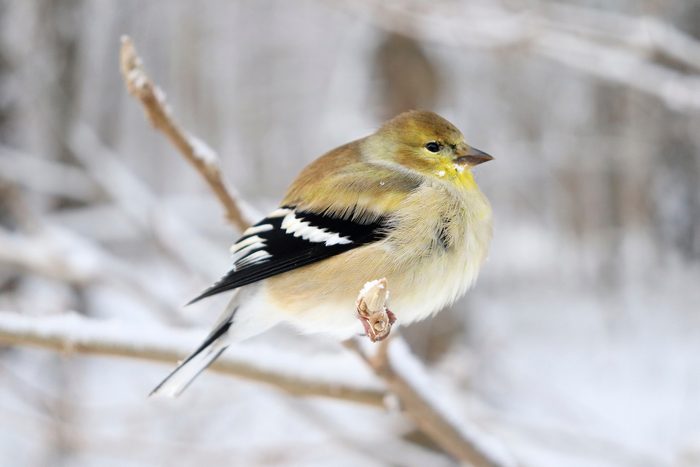
Birds Fluff Their Feathers to Stay Warm in Winter
There’s a reason that birds look bigger during cold weather. David Swanson, a biology professor at the University of South Dakota who has spent 30 years studying how birds handle inclement conditions, says birds assume a heat-conserving posture and fluff their feathers to stay warm in winter. “It’s similar to goose pimples to form an insulation barrier. It’s almost like putting on a coat,” David says.
Learn how to help birds in cold winter weather.
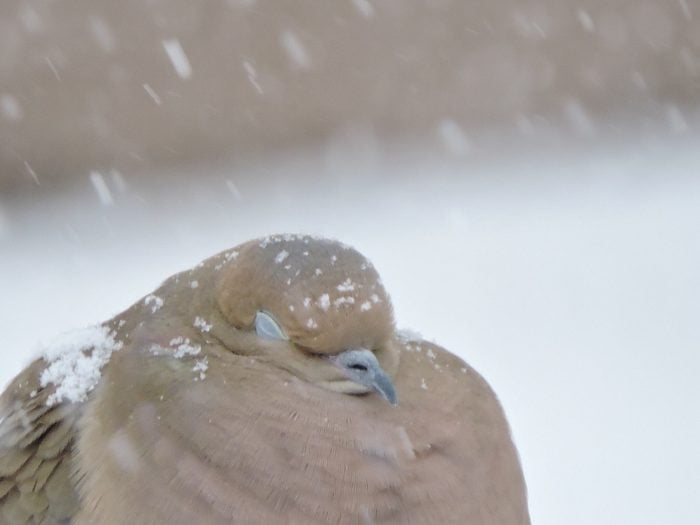
Changing Blood Flow for Warmth
David also notes that birds can readily change their blood flow to control what parts of the body remain warm. “When it’s hot outside, they flush heat,” he says. “When it’s cold, they restrict blood flow to the skin. They do a good job of reducing heat loss and improving heat capacity.” To assist this strategy, they’ll tuck a foot, or both feet, and their bills under their feathers because these areas are prone to heat loss.
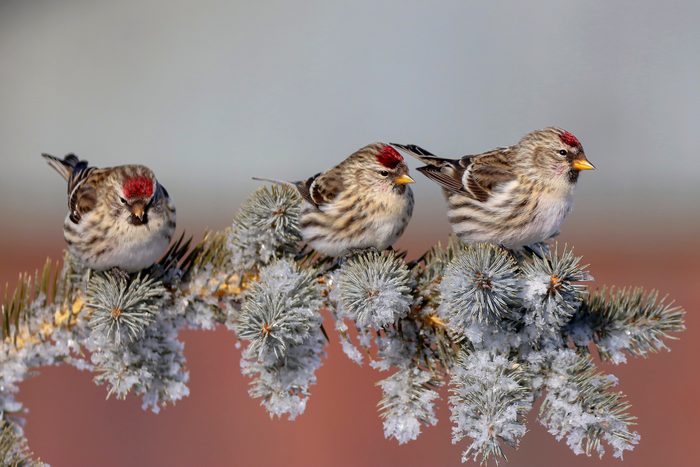
Shivering to Produce Heat
One of a bird’s most powerful tools for staying warm is shivering. “You don’t think of them shivering all winter, but that’s what they’re doing,” David says. “They turn into little heat-producing machines.” Birds perform more of an isometric exercise where antagonistic muscles work together and produce tension, allowing them to generate heat without exposing more body surface area, which would chill.
The science of shivers: The ability to shiver constantly is based at the cellular level. Birds have more mitochondria packed into their cells, which increases the capacity of the cells to produce ATP, an energy-carrying molecule. This allows birds to continue shivering to maintain their temperature despite cold conditions.
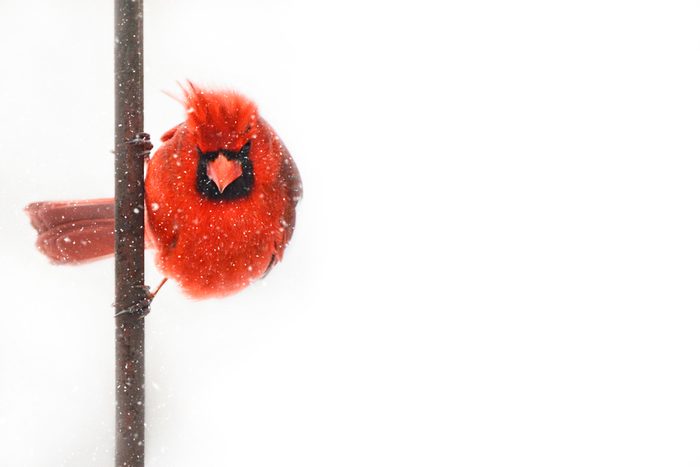
Building Bigger Muscles
To further enhance their shivering capacity, David says they “build a bigger furnace and increase the efficiency of the furnace.” His studies indicate that many birds increase the size of their flight muscles by 10% to 15%, which is similar to a change that occurs during migration.
Discover the truth about common winter birds myths.
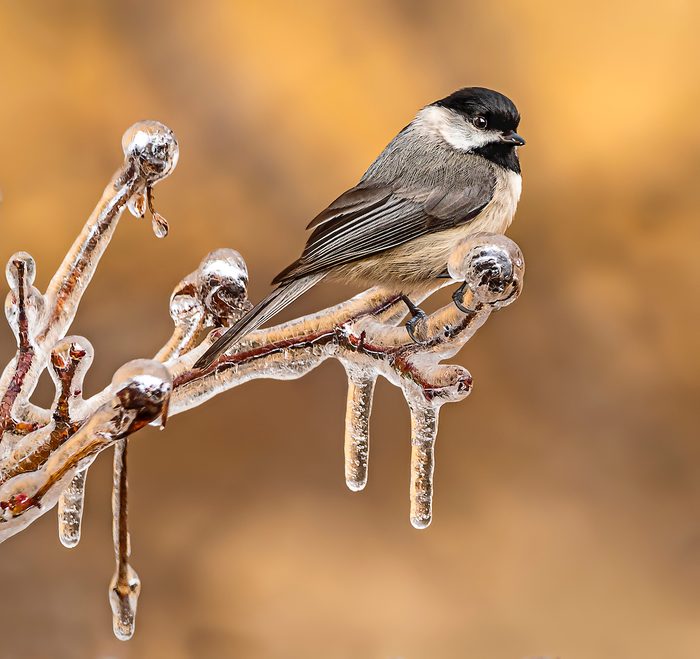
Putting on Extra Fat
“Most songbirds do get fatter in the winter. They store it by the wishbone and on the belly,” David says. Instead of insulative qualities, he says, “it’s just fuel storage.” This allows them to weather prolonged storms when they cannot forage for food. To do this, he says, “it’s essential that they find food.” Some birds, such as chickadees, woodpeckers and nuthatches, cache seeds in the nooks and crannies of tree bark or shrubs. Others rely on feeders.
Necessary Nutrients: It’s rare for birds to feed during a storm event, but having food nearby is beneficial once the bad weather subsides. Depending on the species in your area, look for high-quality sunflower, safflower or Nyjer seeds—and offer suet or peanut butter for high-energy fats.
Check out the 5 foods you should feed birds in winter.
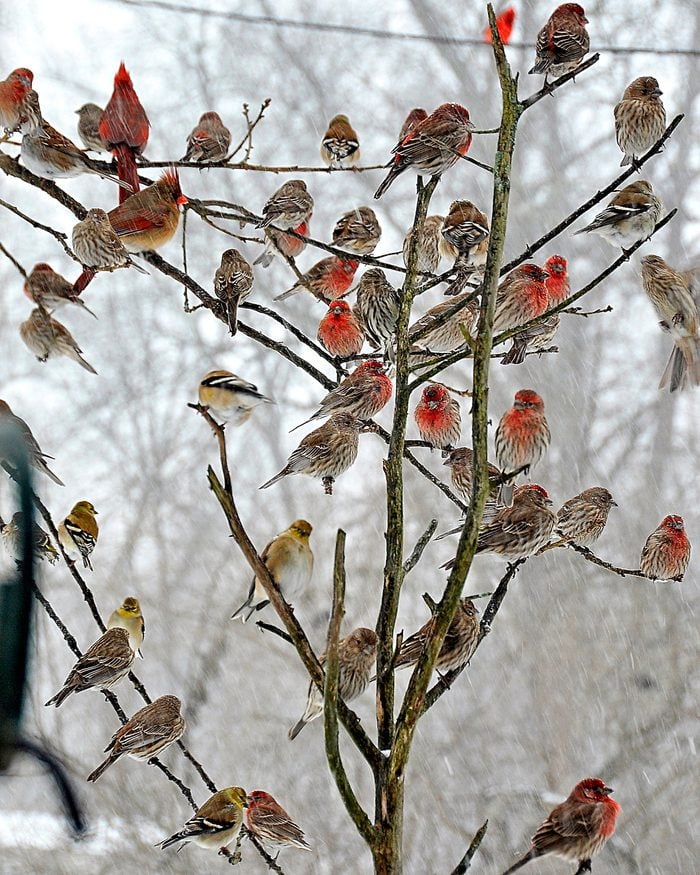
Roosting and Huddling Together
Another heat-saving strategy is roosting, or at least huddling, together. While cavity-nesting birds find shelter within trees or similar areas, others sit side by side to reduce overall exposure.
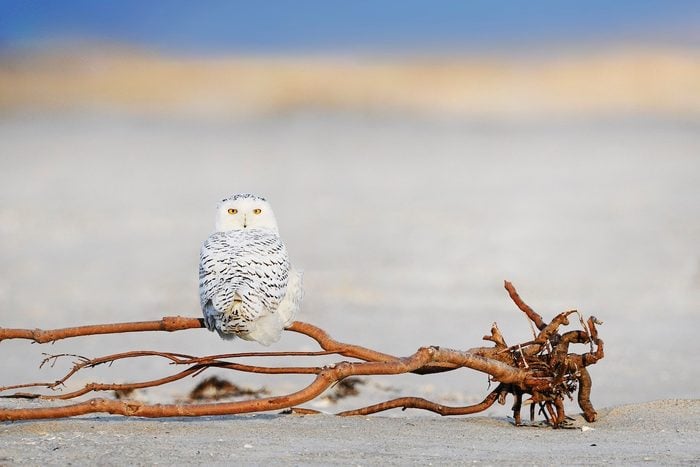
Snowy Owls Irrupt in High Population Years
Snowy owls sport striking white plumage and piercing yellow eyes. They are true dwellers of the Arctic, where lemmings are their favorite food. Snowies hunt any time of day during the summer. They are the heaviest owl in North America at about 4 pounds and their thick feathers insulate them from the cold. These thick feathers are just one answer to the question of how do birds stay warm in winter. Snowy owls show up during the winter around the Great Lakes, northern New England and the north-central plains, sometimes in considerable numbers, looking for prey.
“These periodic irruptions are not, as widely assumed, caused by a lack of prey in the Arctic, but the reverse,” says Scott Weidensaul, ornithologist and co-founder of Project SNOWstorm, which specifically studies snowy owls. “When there’s a productive breeding season in the North, itself a result of a boom in lemming populations, all those young owls making their first migration south produce the periodic invasions. Far from being desperate and starving, most of them are perfectly healthy.”
Check out our top tips for feeding birds in winter.
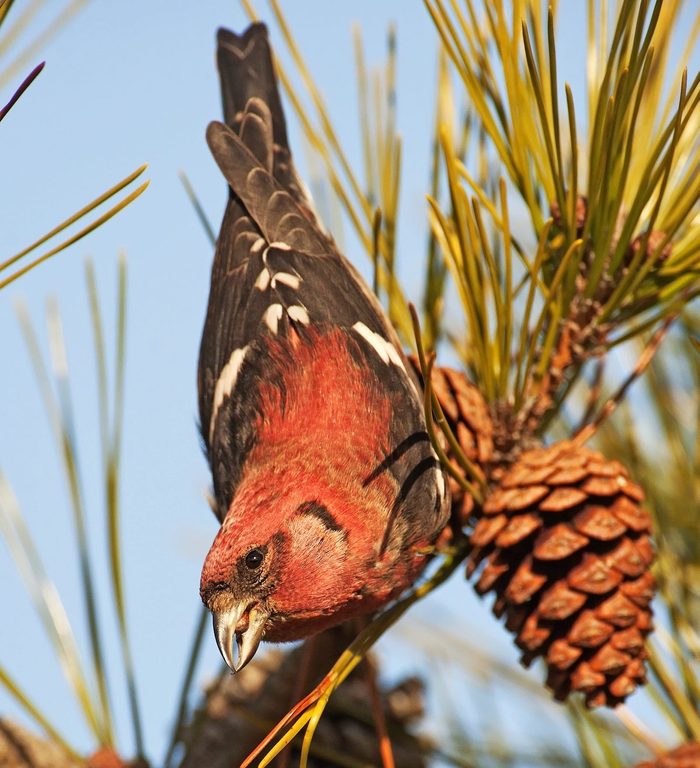
Crossbills Look for Conifer Cones
Crossbills, common across Canada and western boreal regions, are best known for their twisted beaks, the tips of which don’t match up. With these unique crossed bills, they pry open conifer cones to get the nutritious seeds inside. When food is plentiful, crossbills breed, even during the winter. If there are no cones, they irrupt, sometimes coming to feeders stuffed with sunflower seeds.
“Crossbills will feed when there’s 3 feet of snow on the ground, but if the snow is heavy and wet or there’s an ice storm, they’ll move,” says Matt Young, founder and president of the Finch Research Network. “They only come to feeders as a last resort and usually in late winter or early spring when wild food is limited.”
Wondering if crossbills might visit your backyard this year? Check out the updated winter finch forecast.
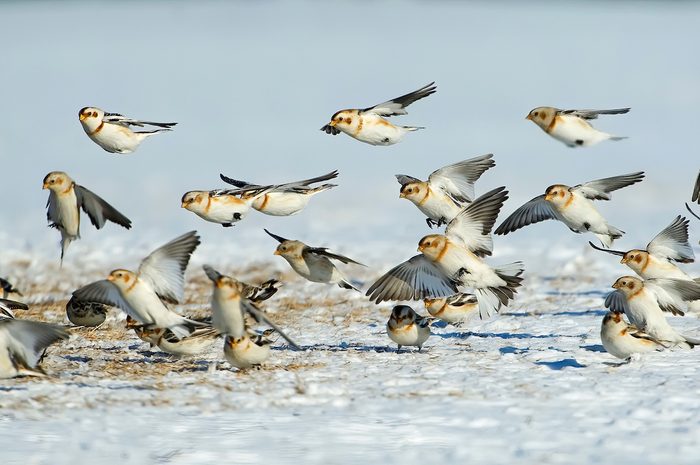
Snow Buntings Have High Feather Density
Snow buntings breed above the Arctic Circle and are the northernmost songbirds. Males arrive in spring about a month ahead of females, withstanding subzero temperatures to claim a nest site among the cold rocks. Once the females lay their eggs, males deliver food so their mates can stay in the nest most of the time.
During the winter, snow buntings head as far south as the central United States, where you might spot them as they flit from field to field. “There isn’t much for trees where snow buntings come from, so they feed where they can access the ground,” says Melissa Mayntz, author of Migration: Exploring the Remarkable Journeys of Birds. “When I lived in Utah, I would throw seeds under a table on our patio. The snow buntings would quickly figure out ‘food!’ They like mixed seeds, try a blend of millet and black oil sunflower seeds.”
As one of their winter survival strategies, snow buntings don’t molt twice like most birds. In spring, their worn-down feathers reveal new ones. What’s more, their feather density is higher to prevent heat loss, especially at the base of their bills and on their lower legs. They’ll also fly or flop into snowdrifts, making a little hollow to stay warm in winter.
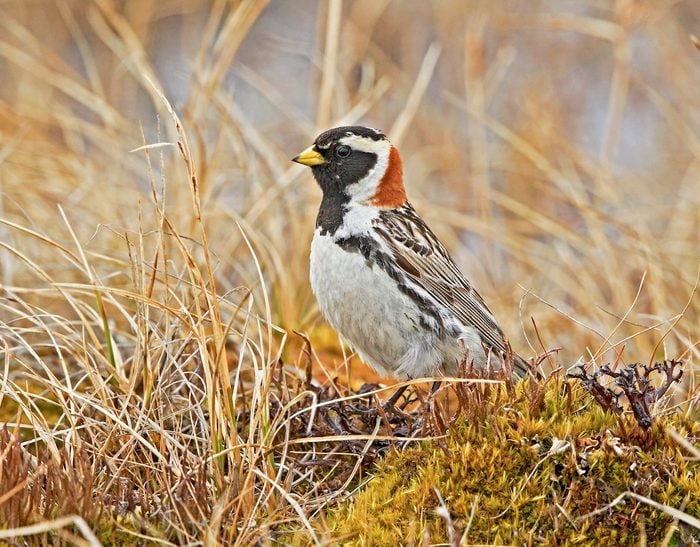
Lapland Longspurs Flock on Fields
After breeding on the Arctic tundra, Lapland longspurs form large nomadic flocks during the winter—sometimes groups consist of more than a million birds! The chunky songbirds forage for seeds in patches of low grass and vegetation and on bare ground, especially on agricultural lands and coastal dunes.
“Lapland longspurs will flock with highly social snow buntings,” Melissa says. “Both species are ground feeders and have similar food preferences and behaviors.”
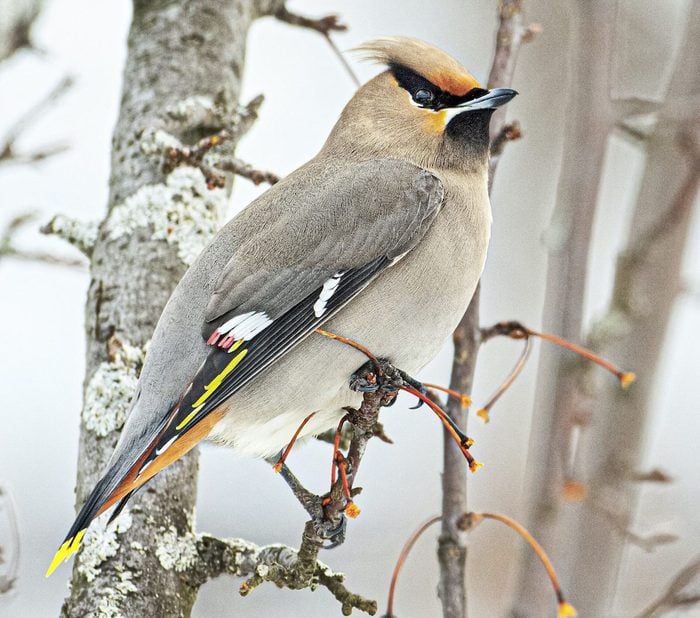
Bohemian Waxwings Look for Berries
Bohemian waxwings are another northern breeder, in this case from Alaska to Hudson Bay. But during the winter they wander like black-masked vagabonds across northwestern United States and western Canada in search of fruits and berries. They also irregularly drift into New England, the northern Midwest and Ontario.
“Bohemian waxwings are unpredictable, suddenly appearing and then leaving. They fly to the best food source, strip it clean, then move on,” Melissa says. “They travel in large groups, following the leader to find the best feeding spots. If you plant fruit trees, such as crabapples or even junipers, and leave the fruit, the odds are high they’ll find them.”
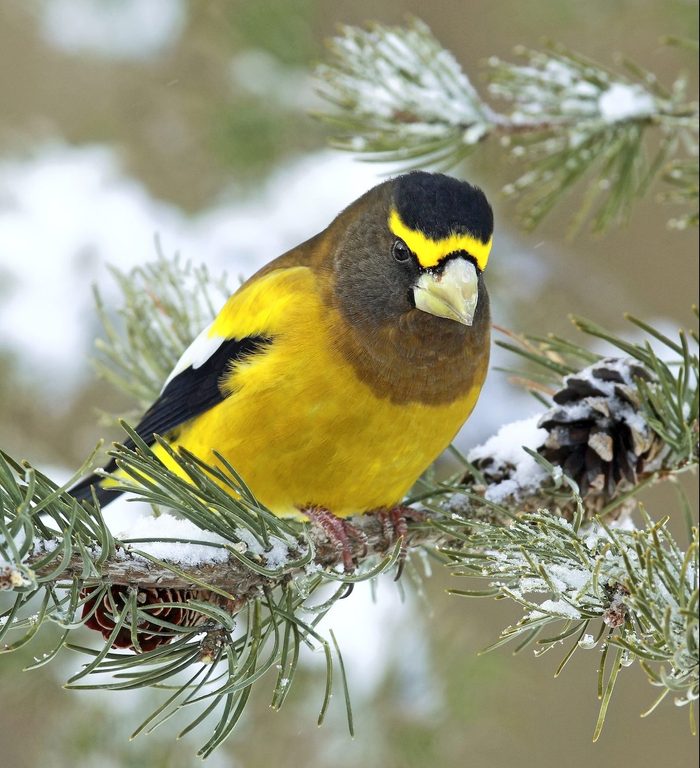
Evening Grosbeaks Migrate to Find Food
These hulking finches, with conical bills and striking yellow forehead patches and chests on males, are like a burst of sunshine when they visit feeders. Evening grosbeaks breed in the North and West but migrate south during winter as far as they need to for food. They love sunflower seeds, though the planting of ornamental box elders is credited with their spread across the northeastern and mid-Atlantic states.
“Evening grosbeaks irrupt farther south during the winter when there are food shortages and to escape inclement weather,” Matt says. “They like platform or hopper feeders, because they travel in large, gregarious flocks and have voracious appetites, hence their nicknames ‘gross-pigs’ or ‘ grocery-beaks.’ ”
Learn more about irruptions: a sudden surge of of new birds in town.
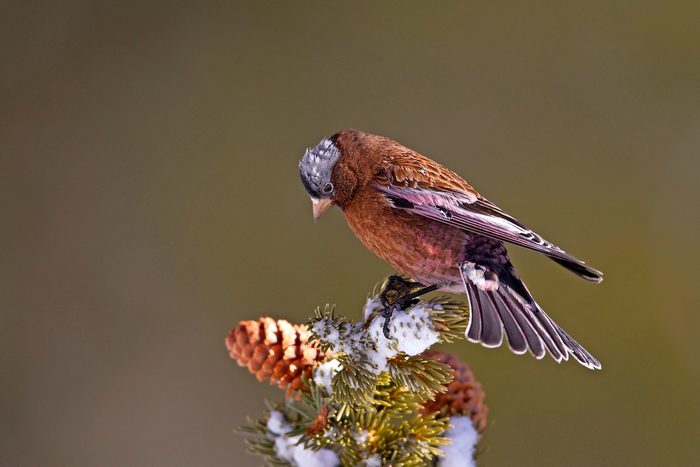
Rosy-Finches Go to Lower Elevations
Three species of rosy-finches are closely related: black, gray-crowned (above) and brown-capped. Black and brown-capped rosy-finches are among the highest-elevation breeding birds in North America, often nesting above 14,000 feet. To stay warm in winter, these birds roost together for protection, often in conifers.
“They’ll stay as long as they can up high, until they run out of food, then they’ll move lower to protected valleys. A few hundred feet can mean the difference between a snowstorm and no snow. Or they’ll go to the leeward side of a hill,” Matt says. “They’re attracted to weed fields in the winter for seeds, but they’ll come to a feeder filled with sunflower seeds or Nyjer seed.”
Check out the types of winter finches you should look for in cold weather.
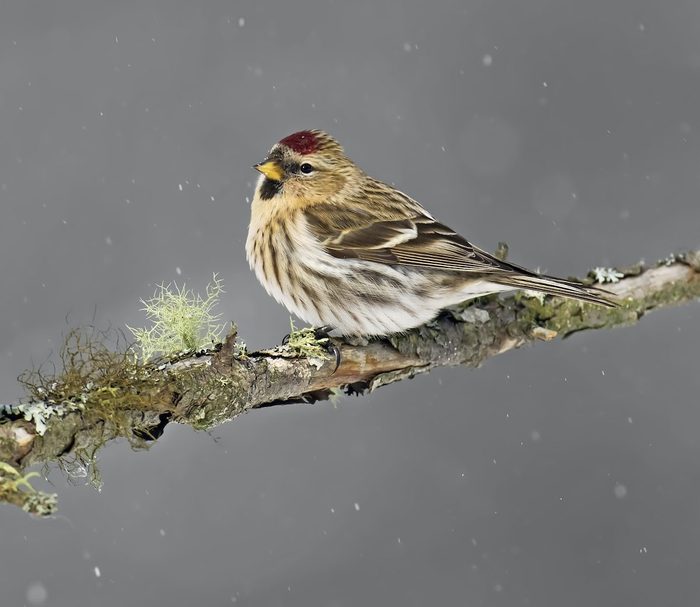
Common Redpolls Tunnel in Snow
Here’s another unique answer to the question of how do birds stay warm in winter. Common redpolls, with their red chests and red caps, and their paler cousins, hoary redpolls, withstand winter’s extremes by tunneling into the snow to stay warm during the night. “Redpolls are the most northern of the finches. They even bathe in the snow!” Matt says.
To feed, redpolls seek out tiny seeds from birch, alder, conifers and many other plants, gathering them into their throat pouches and flying to a more protected spot to eat. In winter, they can ingest 40% of their weight in seed a day. By putting on about 30% more feathers during the winter, these residents of the Arctic and northernmost boreal forests can survive minus 65 degrees, but they’ll migrate as far south as the central United States, congregating at feeders. “They’ll eat sunflower seeds, but they love thistle and Nyjer,” Matt says.
Sources:
https://academic.oup.com/beheco/article/11/1/27/239210
https://www.fws.gov/story/how-do-birds-keep-warm-winter#:~:text=All

